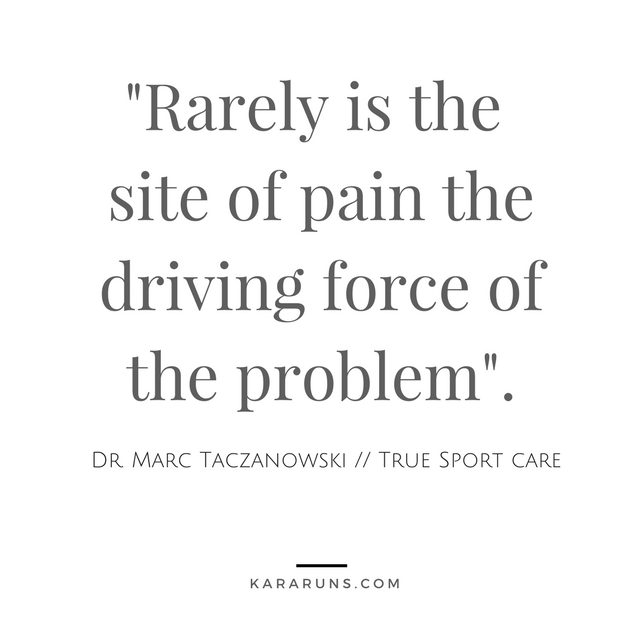I once read that pain and injury are not the same. We can have pain without injury, which I don’t think I ever truly understood.
Is this as mind-blowing to anyone else?
I remembered this as I sat on my couch a few weeks ago, wondering why the heck my random back-of-knee “running injury” returned. As I’ve begrudgingly mentioned a million times already, I wasn’t able to run while pregnant…so why was I feeling those random pangs again?! I thought I was in the clear for any and all running injuries due to the fact that I WASN’T RUNNING. In the past, I assumed I must be running too fast, too much, or increasing mileage too quickly. Every time I started feeling it, I’d feel the despair that comes with beginning the rehabilitation of another injury.
Now I’m realizing it’s probably just pain at this stage. Complete rest alone won’t heal me (like I always thought in the past). The good news is, these deficiencies can usually be easily corrected with the proper strengthening movements. As I mentioned in my last post, I’m certain I need to work on muscle imbalances that can be aggravated with activities of daily life (I blame sitting!).
First, some background. Dr. Taczanowski determines athletes’ deficiencies and prescribes a specific tailored program to correct those deficiencies. What caught my eye and inspired me to chat with him was the claim that his methodology and movement analysis is so effective he can do it virtually without ever laying a hand on the athlete. He was one of two doctors in his field selected by the US Olympic Team to travel to Sochi, Russia in 2014. JEALOUS. His comments about how runners’ favorite exercise, the glute bridge, can go wrong and his views on the “best” exercises for athletes are intriguing. Is there an elixir of exercises we all should do to stay balanced? Check out his answers!
You can evaluate injuries virtually. How do you perform such magic?!
Watching someone move, understanding the body’s inclinations, and getting feedback on what the client is feeling during the analysis is really all we need to evaluate an athlete in a comprehensive manner.
You say “rarely is the sight of pain the driving force of the problem”. Can you explain why and how you determine the origin of the injury?
Plantar Fasciitis, for example, is pain in the bottom or sole of the foot. This can stem from weakness and tightness elsewhere such as the glutes, hamstrings, or hip flexors. The result from these imperceivable weaknesses is a tight calf which pulls on the fascial covering on the bottom of the foot. We can stretch and roll out the bottom of the foot as much as we would like, but the issue will never resolve with this approach. Address the weaknesses in the kinetic chain and the condition reverses.
 What is the kinetic chain and how does it relate with muscle imbalances?
What is the kinetic chain and how does it relate with muscle imbalances?
We have natural movements like throwing, squatting, and running which have their inherent chains that drive their movements. Typically for running, a “posterior” chain which includes the low back, glutes, hamstrings, calves, and feet, provide the propulsive force to move a body upwards and forwards. From a detailed investigation we can determine which muscles are participating effectively and which are not. We strengthen the underperforming muscles and attenuate the over-performing muscles, which balances the system making the athlete more efficient and reducing stress on the system.
What can the average athlete do to prevent injury? Are there any specific exercises we all should do daily/weekly do prevent common injuries + build strength in muscles we use often?
The average athlete needs to become an expert in identifying these compensations and imbalances in themselves. Here you will find a checklist of identifying factors that can lead someone to believe they are on the road to experiencing dysfunction due to an imbalance. The second question is unfortunately one of the issues with Sports Medicine as a whole today.
Everyone is looking for the panacea when it comes to rehabilitative exercises.
Sure there are great general exercises for the masses, however even if performed with the utmost consideration for form, the exercise can be useless depending on what the athlete feels. I will use the example of a glute bridge, an exercise designed to target the glutes, of course. I can’t tell you how many times someone comes into the office and they demonstrate this exercise well, but I ask them where they feel it, and they report somewhere other than the glutes. Therefore this is no longer a glute bridge, but a back bridge, or a calf bridge. This also means their glutes will not benefit. We are so incredibly nit-picky with our movements that until someone feels the exercise in the target muscle, we don’t move on.
Which exercise have you found most helpful in building a stronger runner’s body? My favs are the glute bridge and clamshells, both with bands (…because that’s what my physical therapist always made me focus on!)
I really like glute bridges too. It’s a very modifiable exercise, changing up your feet positioning to target certain muscles. I used to do them with weights but now that I’m always hurt, it’s all about the resistance bands. That also makes them easy to do anywhere!
I think he is right about the sight of pain not always being the problem. Often it’s the area above or below on the kinetic chain- and running injuries aren’t really about running. It’s that if we have an imbalance, running and repetitive motion on that imbalance for so many hours a week are going to cause an injury.
Definitely! Correcting the imbalance is the key before we start ramping up the mileage!